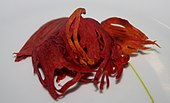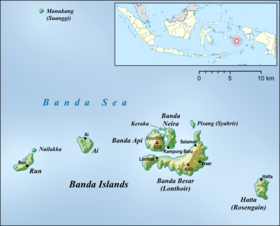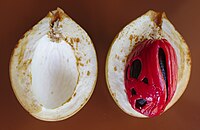Nutmeg

Nutmeg is the seed or ground spice of several species of the genus Myristica.[1] Myristica fragrans (fragrant nutmeg or true nutmeg) is a dark-leaved evergreen tree cultivated for two spices derived from its fruit: nutmeg, from its seed, and mace, from the seed covering. It is also a commercial source of an essential oil and nutmeg butter. The California nutmeg, Torreya californica, has a seed of similar appearance, but is not closely related to Myristica fragrans, and is not used as a spice. Guatemala and Indonesia combined produced 68% of the world supply of nutmeg in 2018.
If consumed in amounts exceeding its typical use as a spice, nutmeg powder may produce allergic reactions, cause contact dermatitis, or have psychoactive effects.[2] Although used in traditional medicine for treating various disorders, nutmeg has no known medicinal value.[2]
Common nutmeg
Nutmeg is the spice made by grinding the seed of the fragrant nutmeg (Myristica fragrans) tree into powder. The spice has a distinctive pungent fragrance and a warm slightly sweet taste; it is used to flavor many kinds of baked goods, confections, puddings, potatoes, meats, sausages, sauces, vegetables, and such beverages as eggnog.[3]
The seeds are dried gradually in the sun over a period of six to eight weeks. During this time the nutmeg shrinks away from its hard seed coat until the kernels rattle in their shells when shaken. The shell is then broken with a wooden club and the nutmegs are picked out. Dried nutmegs are grayish brown ovals with furrowed surfaces.[3] The nutmegs are roughly egg-shaped, about 20.5–30 mm (0.81–1.18 in) long and 15–18 mm (0.59–0.71 in) wide, weighing 5–10 g (0.18–0.35 oz) dried.
Two other species of genus Myristica with different flavors, M. malabarica and M. argentea, are sometimes used to adulterate nutmeg as a spice.[4]
Mace

Mace is the spice made from the reddish seed covering (aril) of the nutmeg seed. Its flavour is similar to nutmeg but more delicate; it is used to flavour baked goods, meat, fish, vegetables and in preserving and pickling.[5]
In the processing of mace, the crimson-colored aril is removed from the nutmeg seed that it envelops and is flattened out and dried for 10 to 14 days. Its color changes to pale yellow, orange, or tan. Whole dry mace consists of flat pieces—smooth, horny, and brittle—about 40 mm (1.6 in) long.[6]
Botany and cultivation

The most important commercial species is the common, true or fragrant nutmeg, Myristica fragrans (Myristicaceae), native to the Moluccas (or Spice Islands) of Indonesia.[7][8] It is also cultivated on Penang Island in Malaysia, in the Caribbean, especially in Grenada, and in Kerala, a state formerly known as Malabar in ancient writings as the hub of spice trading, in southern India. In the 17th-century work Hortus Botanicus Malabaricus, Hendrik van Rheede records that Indians learned the usage of nutmeg from the Indonesians through ancient trade routes.
Nutmeg trees are dioecious plants which are propagated sexually (seeds) and asexually (cuttings or grafting). Sexual propagation yields 50% male seedlings, which are unproductive. As there is no reliable method of determining plant sex before flowering in the sixth to eighth year, and sexual reproduction bears inconsistent yields, grafting is the preferred method of propagation. Epicotyl grafting (a variation of cleft grafting using seedlings), approach grafting, and patch budding have proved successful, with epicotyl grafting being the most widely adopted standard. Air layering is an alternative though not preferred method because of its low (35–40%) success rate.
The first harvest of nutmeg trees takes place seven to nine years after planting, and the trees reach full production after twenty years.
-
Nutmeg fruit
-
Red aril and seed within fruit
-
Aril surrounding nutmeg seed
Culinary uses

Spice
Nutmeg and mace have similar sensory qualities, with nutmeg having a slightly sweeter and mace a more delicate flavour. Mace is often preferred in light dishes for the bright orange, saffron-like hue it imparts. Nutmeg is used for flavouring many dishes, and nowadays is mostly found in Western supermarkets in ground or grated form. Whole nutmeg can also be ground at home using a grater specifically designed for nutmeg[9] or a multi-purpose grating tool.[10]
In Indonesian cuisine, nutmeg is used in various dishes,[11] mainly in many spicy soups, such as some variant of soto, konro, oxtail soup, sup iga (ribs soup), bakso and sup kambing. It is also used in gravy for meat dishes, such as semur beef stew, ribs with tomato, and European derived dishes such as bistik (beef steak), rolade (minced meat roll) and bistik lidah (beef tongue steak).
In Indian cuisine, nutmeg is used in many sweet, as well as savoury, dishes (predominantly in Mughlai cuisine). In Kerala Malabar region, grated nutmeg is used in meat preparations and also sparingly added to desserts for the flavour. It may also be used in small quantities in garam masala. Ground nutmeg is also smoked in India.[12]
In traditional European cuisine, nutmeg and mace are used especially in potato dishes and in processed meat products; they are also used in soups, sauces, and baked goods. It is also commonly used in rice pudding. In Dutch cuisine, nutmeg is added to vegetables such as Brussels sprouts, cauliflower, and string beans. Nutmeg is a traditional ingredient in mulled cider, mulled wine, and eggnog. In Scotland, mace and nutmeg are usually both ingredients in haggis. In Italian cuisine, nutmeg is used as part of the stuffing for many regional meat-filled dumplings like tortellini, as well as for the traditional meatloaf. Nutmeg is a common spice for pumpkin pie and in recipes for other winter squashes, such as baked acorn squash. In the Caribbean, nutmeg is often used in drinks, such as the Bushwacker, Painkiller, and Barbados rum punch. Typically, it is a sprinkle on top of the drink.
Fruit
The pericarp (fruit covering) is used to make jam, or is finely sliced, cooked with sugar, and crystallised to make a fragrant candy. Sliced nutmeg fruit flesh is made as manisan (sweets), either wet, which is seasoned in sugary syrup liquid, or dry coated with sugar, a dessert called manisan pala in Indonesia. In Penang cuisine, dried, shredded nutmeg rind with sugar coating is used as toppings on the uniquely Penang ais kacang. Nutmeg rind is also blended (creating a fresh, green, tangy taste and white colour juice) or boiled (resulting in a much sweeter and brown juice) to make iced nutmeg juice. In Kerala Malabar region of India, it is used for juice, pickles and chutney.[12]
Essential oil
The essential oil obtained by steam distillation of ground nutmeg[13] is used in the perfumery and pharmaceutical industries. The volatile fraction contains dozens of terpenes and phenylpropanoids, including d-pinene, limonene, d-borneol, l-terpineol, geraniol, safrol, and myristicin.[13][14][15] In its pure form, myristicin is a toxin, and consumption of excessive amounts of nutmeg can result in myristicin poisoning.[16]
The oil is colorless or light yellow, and smells and tastes of nutmeg. It is used as a natural food flavoring in baked goods, syrups, beverages, and sweets. It is used to replace ground nutmeg, as it leaves no particles in the food. The essential oil is also used in the manufacturing of toothpaste and cough syrups.[17]
Nutmeg butter
Nutmeg butter is obtained from the nut by expression. It is semisolid, reddish-brown in colour, and has the taste and smell of nutmeg itself.[13]About 75% (by weight) of nutmeg butter is trimyristin, which can be turned into myristic acid, a 14-carbon fatty acid, which can be used as a replacement for cocoa butter, can be mixed with other fats like cottonseed oil or palm oil, and has applications as an industrial lubricant.
History

The earliest known usage of nutmeg is on the island of Pulau Ai around 3,500 years ago based on residue found on ceramic potsherds.[18][19]
Until the mid-19th century, the small island group of the Banda Islands, which are also known under the name "Spice Islands," was the only location of the production of nutmeg and mace in the world. The Banda Islands are situated in the eastern part of Indonesia, in the province of Maluku. They consist of eleven small volcanic islands, called Neira, Gunung Api, Banda Besar, Rhun, Ai, Hatta, Syahrir, Karaka, Manukan, Nailaka and Batu Kapal, with a total approximate land area of 8,150 hectares.[20]
The Banda Islands became the scene of the earliest European ventures in Asia, in order to get a grip on the spice trade. In August 1511, Afonso de Albuquerque conquered Malacca, which at the time was the hub of Asian trade, on behalf of the king of Portugal. In November of the same year, after having secured Malacca and learning of Banda's location, Albuquerque sent an expedition of three ships led by his friend António de Abreu to find it. Malay pilots, either recruited or forcibly conscripted, guided them via Java, the Lesser Sundas, and Ambon to the Banda Islands, arriving in early 1512.[9] The first Europeans to reach the Banda Islands, the expedition remained for about a month, buying and filling their ships with Banda's nutmeg and mace, and with cloves in which Banda had a thriving entrepôt trade.[10] An early account of Banda is in Suma Oriental, a book written by the Portuguese apothecary Tomé Pires, based in Malacca from 1512 to 1515. Full control of this trade by the Portuguese was not possible, and they remained participants without a foothold in the islands.
In order to obtain a monopoly on the production and trade of nutmeg, the Dutch East India Company (VOC) waged a bloody battle with the Bandanese in 1621. Historian Willard Hanna estimated that before this struggle the islands were populated by approximately 15,000 people, and only 1,000 were left (the Bandanese were killed, starved while fleeing, exiled or sold as slaves).[21] The Company constructed a comprehensive nutmeg plantation system on the islands during the 17th century.
| Nutmeg production, 2018 (includes mace and cardamom) | |
|---|---|
| Country | tonnes |
| Source: FAOSTAT of the United Nations[22] | |
As a result of the Dutch interregnum during the Napoleonic Wars, the British invaded and temporarily took control of the Banda Islands from the Dutch and transplanted nutmeg trees, complete with soil, to Sri Lanka, Penang, Bencoolen, and Singapore.[23] (There is evidence that the tree existed in Sri Lanka even before this.)[24] From these locations they were transplanted to their other colonial holdings elsewhere, notably Zanzibar and Grenada. The national flag of Grenada, adopted in 1974, shows a stylised split-open nutmeg fruit. The Dutch retained control of the Spice Islands until World War II.
It has been suggested that Connecticut received its nickname ("the Nutmeg State", "Nutmegger") from the claim that some unscrupulous Connecticut traders would whittle "nutmeg" out of wood, creating a "wooden nutmeg", a term which later came to mean any type of fraud.[25][26] This narrative may have to do with the issue that one has to grate to obtain the spice powder, not crack a nutmeg, and this may not have been widely known by some purchasers of the product.[25]
Production
In 2018, world production of nutmeg (including mace and cardamom) was 109,284 tonnes, led by Guatemala and Indonesia with 68% combined of the world total (table).
Adverse effects
In the 19th century, nutmeg was thought to be an abortifacient, which led to numerous recorded cases of nutmeg poisoning.[2] Although used as a folk treatment for other ailments, nutmeg has no proven medicinal value.[2] In amounts exceeding its usual use as a spice, nutmeg may interact with anxiolytic drugs, produce allergic reactions, cause contact dermatitis, or evoke acute episodes of psychosis.[2]
Psychoactivity and toxicity
Effects
In low doses, nutmeg produces no noticeable physiological or neurological response, but in large doses, both raw nutmeg freshly ground from kernels, as well as nutmeg oil, have psychoactive effects,[2][27][16] which appear to derive from anticholinergic-like hallucinogenic mechanisms attributed to myristicin and elemicin.[16][28] Myristicin—a monoamine oxidase inhibitor and psychoactive substance[2][16]—can induce convulsions, palpitations, nausea, eventual dehydration, and generalized body pain when consumed in large amounts.[2][27] Nutmeg poisonings occur by accidental consumption in children and by intentional recreational use.[16]
Varying considerably from person to person, nutmeg intoxication may occur with side effects, such as delirium, anxiety, confusion, headaches, nausea, dizziness, dry mouth, eye irritation, or amnesia.[2][16] Intoxication takes several hours before maximum effect is experienced.[2] The effects of nutmeg intoxication may last for several days.[16][27]
Although rarely reported, nutmeg overdose can result in death, especially if combined with other drugs.[16] Incidents of fatal poisoning from nutmeg or myristicin individually are uncommon.[2]
Toxicity during pregnancy
Nutmeg was once considered an abortifacient, but may be safe for culinary use during pregnancy if used only in flavoring amounts.[2] However, if consumed in large quantities, it contains hallucinogens that may affect the fetus, and consequently nutmeg is recommended for avoidance during pregnancy.[29]
Toxicity to pets
While the spicy scent of nutmeg may be attractive to pets, there is potential for toxicity if large amounts are consumed.[30]
References
- ^ "Nutmeg and derivatives (Review)". Food and Agriculture Organization (FAO) of the United Nations. September 1994. Archived from the original on 30 October 2018. Retrieved 29 October 2018.
- ^ a b c d e f g h i j k l "Nutmeg". Drugs.com. 2009. Retrieved 2017-05-04.
- ^ a b "Nutmeg spice". Encyclopædia Britannica Online.
- ^ "Nutmeg". www.clovegarden.com. Retrieved 2017-07-22.
- ^ Small, Ernest (2011). Top 100 Exotic Food Plants. CRC Press. p. 420. ISBN 1439856869. Retrieved 2019-08-27.
- ^ "Mace spice". Encyclopædia Britannica Online.
- ^ Amitav Ghosh (December 30, 2016). "What Nutmeg Can Tell Us About Nafta". New York Times.
- ^ Dotschkal, Janna (2015-06-22). "The Spice Trade's Forgotten Island". National Geographic. Retrieved 2017-04-13.
- ^ Oulton, Randal (18 February 2007). "Nutmeg Graters". CooksInfo.com. Retrieved 8 April 2018.
- ^ Barber, Casey (18 February 2007). "Do you really need a Microplane for your kitchen? Yes, and here's why". today.com. Retrieved 8 November 2019.
- ^ Arthur L. Meyer; Jon M. Vann (2008). The Appetizer Atlas: A World of Small Bites. Houghton Mifflin Harcourt. p. 196. ISBN 978-0-544-17738-3.
- ^ a b Pat Chapman (2007). India Food and Cooking: The Ultimate Book on Indian Cuisine. New Holland Publishers. p. 16. ISBN 978-1-84537-619-2.
- ^ a b c "Description of components of nutmeg". Food and Agriculture Organization of the United Nations. September 1994. Retrieved 2017-04-13.
- ^ Abourashed, E. A.; El-Alfy, A. T. (2016). "Chemical diversity and pharmacological significance of the secondary metabolites of nutmeg (Myristica fragrans Houtt.)". Phytochemistry Reviews. 15 (6): 1035–1056. doi:10.1007/s11101-016-9469-x. PMC 5222521. PMID 28082856.
- ^ Piras, A.; Rosa, A.; Marongiu, B.; Atzeri, A.; Dessì, M. A.; Falconieri, D.; Porcedda, S. (2012). "Extraction and separation of volatile and fixed oils from seeds of Myristica fragrans by supercritical CO₂: Chemical composition and cytotoxic activity on Caco-2 cancer cells". Journal of Food Science. 77 (4): C448–53. doi:10.1111/j.1750-3841.2012.02618.x. PMID 22429024.
- ^ a b c d e f g h Ehrenpreis, J. E.; Deslauriers, C; Lank, P; Armstrong, P. K.; Leikin, J. B. (2014). "Nutmeg Poisonings: A Retrospective Review of 10 Years Experience from the Illinois Poison Center, 2001–2011". Journal of Medical Toxicology. 10 (2): 148–151. doi:10.1007/s13181-013-0379-7. PMC 4057546. PMID 24452991.
- ^ Crask, Paul (2017-11-05). Grenada: Carriacou and Petite Martinique. Bradt Travel Guides. ISBN 9781784770624.
- ^ Peter Lape; Emily Peterson; Daud Tanudirjo; Chung-Ching Shiung; Gyoung-Ah Lee; Judith Field; Adelle Coster (2018). "New Data from an Open Neolithic Site in Eastern Indonesia". Asian Perspectives. 57 (2): 222–243. doi:10.1353/asi.2018.0015.
- ^ "3,500-year-old pumpkin spice? Archaeologists find the earliest use of nutmeg as a food". EurekAlert!. Retrieved 4 October 2018.
- ^ Centre, UNESCO World Heritage. "The Historic and Marine Landscape of the Banda Islands – UNESCO World Heritage Centre". whc.unesco.org. Retrieved 2016-03-04.
- ^ Hanna, Willard (1991). Indonesian Banda: Colonialism and Its Aftermath in the Nutmeg Islands. Moluccas, East Indonesia: Yayasan Warisan dan Budaya Banda Neira.
- ^ "Nutmeg production in 2018 (includes mace and cardamom), Crops/Regions/World list/Production Quantity (pick lists)". UN Food and Agriculture Organization, Corporate Statistical Database (FAOSTAT). 2019. Retrieved 17 March 2020.
- ^ Giles Milton, Nathaniel's Nutmeg, 1999, London: Hodder and Stoughton, ISBN 0-340-69675-3
- ^ "'Nutmeg', Department of Export Agriculture website". Archived from the original on 2019-04-18. Retrieved 2020-04-22.
- ^ a b Rebecca Furer (12 August 2011). "What is a Nutmegger?". Connecticut Public Radio. Retrieved 29 October 2018.
- ^ "Nicknames for Connecticut". Connecticut State Library. 2018. Retrieved 29 October 2018.
- ^ a b c Demetriades, A. K.; Wallman, P. D.; McGuiness, A.; Gavalas, M. C. (2005). "Low Cost, High Risk: Accidental Nutmeg Intoxication". Emergency Medicine Journal. 22 (3): 223–225. doi:10.1136/emj.2002.004168. PMC 1726685. PMID 15735280.
- ^ McKenna, A.; Nordt, S. P.; Ryan, J. (2004). "Acute Nutmeg Poisoning". European Journal of Emergency Medicine. 11 (4): 240–241. doi:10.1097/01.mej.0000127649.69328.a5. PMID 15249817.
- ^ "Herb and drug safety chart". BabyCentre UK. 2018. Retrieved 29 October 2018.
- ^ Charlotte Flint (2018). "Nutmeg Toxicity". Pet Poison Helpline. Retrieved 29 October 2018.



